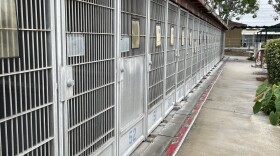When we eat a food that contains a combination of both fat and carbs, the reward centers in our brains go nuts, tell us to eat more and block the part of the brain that manages food consumption, according to recent research.
It was a great survival mechanism for the first hundreds of thousands of years in human evolution when food was comparatively scarce.
RELATED: Personalized Diets: Can Your Genes Really Tell You What To Eat?
But that’s not the case today, at least not at the San Diego County Fair. It’s one example of an environment rife with processed foods high in fat and carbohydrates.
On a recent day at the fair, Gaspar Marquez was eating something he said was so delectable, they call it a unicorn. “It’s a cinnamon roll covered with frosting, sprinkles, fruity pebbles and then unicorn bacon,” said Marquez.
Whether any of that actually sounds appetizing or not, for some reason we still crave those kinds of concoctions.
Dr. Eduardo Grunvald is an obesity medicine physician and directs the Weight Management program at UC San Diego. He said we desire the combination of carbs and fat without even thinking about it. We want it on a subconscious level because it’s actually a survival mechanism.
“So our genetic makeup is wired to always be seeking consumption of food or calories. It’s also wired to always be sort of driven to consume high-calorie dense food. It’s just that in nature it’s hard to come by,” Grunvald said.
RELATED: Frozen Food Fan? As Sales Rise, Studies Show Frozen Produce Is As Healthy As Fresh
A recent study in the "Cell Metabolism Journal" suggests the "not-so-natural" man-made foods that are rich with both fat and carbs — like ice cream, cakes and pies — overstimulate our brains. The study says they act like a drug for most people and interfere with the part of the brain that regulates consumption. So not only do we crave fatty sweets, we often overeat them.
Grunvald said there are two major systems in the brain that regulate our weight and calorie intake. The first is the hypothalamus, which regulates our weight set point, the way a thermostat regulates room temperature. It’s a primitive part of the brain that keeps us from starving to death when there are periods of food scarcity.
“It's all really regulated by the brain so there’s different structures in the brain that regulate our weight through how we eat which is below our conscious recognition,” Grunvald said.
RELATED:Bariatric Surgery Helps Teens With Severe Obesity Reduce Heart Disease Risk
He said the other part of the brain regulating weight is the mesolimbic system: a group of structures involved with "reward-driven behavior" and stimulated by the neurotransmitter dopamine. These structures produce the sensation of pleasure, which can be created by eating pizza or ice cream. The problem in our environment is that these brain structures are constantly stimulated by the abundance of food that’s high in fat and carbs.
“There is a very complex biology underlying many people’s problem and in order to address it you have to address the behavioral aspect and many times the biological aspect,” Grunvald said.
So, while there’s a fix, it’s definitely not magic and the only unicorn is the one drenched with icing and covered with fruity pebbles along the Sweet Tasty Journey at the San Diego County Fair.






